Belkin F5D7632-4V5 ADSL2+ Modem with Wireless G Router User Manual P74725uk A F5D7632uk4 man indd
Belkin International, Inc. ADSL2+ Modem with Wireless G Router P74725uk A F5D7632uk4 man indd
Belkin >
Contents
- 1. user manual part 1
- 2. user manual part 2
- 3. user manual part 3
user manual part 1
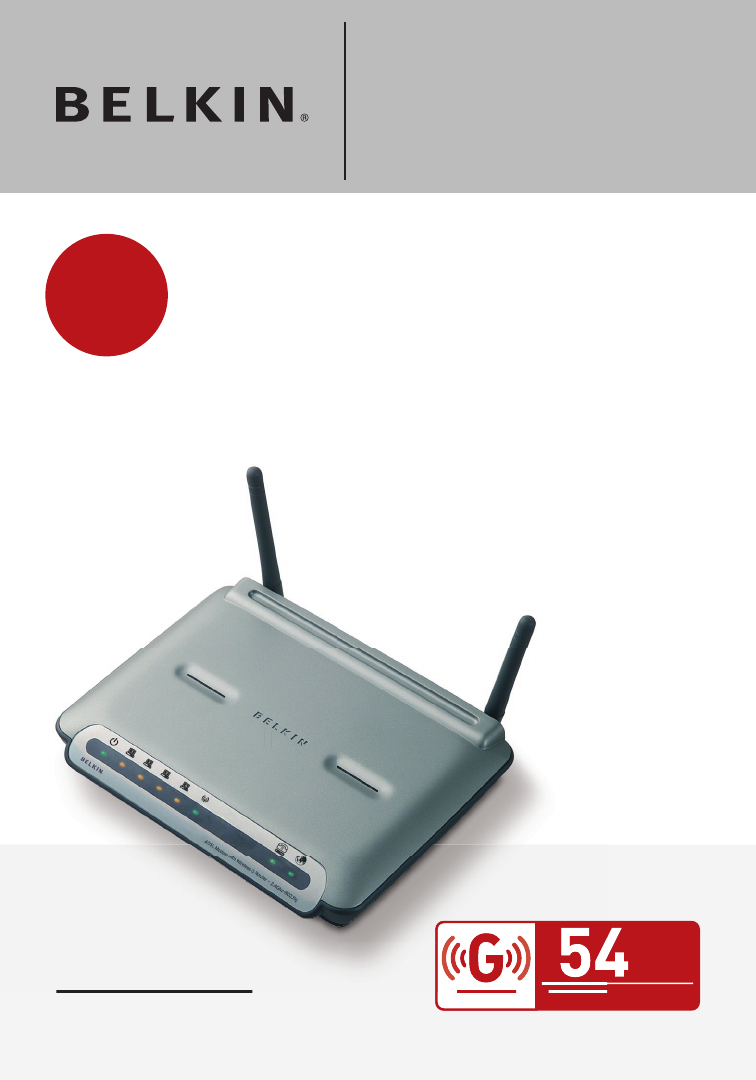
2.4GHz • Wireless802.11b
Ethernet
E
Wired
Mbps
10/100
Ethernet
Gigabit
E
Wired
Mbps
10/100/1000
Gigabit Ethernet
Mbps
2.4GHz • Wireless802.11g
Mbps
Share
F5D7632uk4v3000
Network your computers and
share your ADSL Internet access
User Manual
ADSL Modem with
Wireless G Router
Designed to Meet ADSL2+ Specification
2.4GHz • Wir
802.11g
User Manual

3
Table of Contents
3
1 Introduction . . . . . . . . . . . . . . . . . . . . . . . . . . . . . . . . . . . . . . . . . . 3
Product Features . . . . . . . . . . . . . . . . . . . . . . . . . . . . . . . . . . . . 3
Benefits of a Home Network . . . . . . . . . . . . . . . . . . . . . . . . . . . 5
Advantages of a Belkin Wireless Network. . . . . . . . . . . . . . . . . 5
2 Make Sure You Have the Following . . . . . . . . . . . . . . . . . . . . . . . 6
Package Contents . . . . . . . . . . . . . . . . . . . . . . . . . . . . . . . . . . . 6
System Requirements . . . . . . . . . . . . . . . . . . . . . . . . . . . . . . . . 6
Internet Connection Settings . . . . . . . . . . . . . . . . . . . . . . . . . . . 6
3 Knowing your Router . . . . . . . . . . . . . . . . . . . . . . . . . . . . . . . . . . 5
4 Connecting your Router . . . . . . . . . . . . . . . . . . . . . . . . . . . . . . . 10
Positioning your Router . . . . . . . . . . . . . . . . . . . . . . . . . . . . . . 10
Connecting your Computers . . . . . . . . . . . . . . . . . . . . . . . . . . 10
Connecting your ADSL Line. . . . . . . . . . . . . . . . . . . . . . . . . . . 11
Powering up your Router . . . . . . . . . . . . . . . . . . . . . . . . . . . . . 12
Running the Setup Wizard . . . . . . . . . . . . . . . . . . . . . . . . . . . . 13
5 Manually Configuring Your Router . . . . . . . . . . . . . . . . . . . . . . 17
Understanding the Web-Based User Interface . . . . . . . . . . . . 17
Changing LAN Settings . . . . . . . . . . . . . . . . . . . . . . . . . . . . . . 19
DHCP Client List. . . . . . . . . . . . . . . . . . . . . . . . . . . . . . . . . . . . 21
Internet WAN. . . . . . . . . . . . . . . . . . . . . . . . . . . . . . . . . . . . . . . 21
Wireless . . . . . . . . . . . . . . . . . . . . . . . . . . . . . . . . . . . . . . . . . . 28
Firewall . . . . . . . . . . . . . . . . . . . . . . . . . . . . . . . . . . . . . . . . . . . 48
Utilities . . . . . . . . . . . . . . . . . . . . . . . . . . . . . . . . . . . . . . . . . . . 57
6 Setting up your Computers . . . . . . . . . . . . . . . . . . . . . . . . . . . . 69
Manually Configuring Network Adapters. . . . . . . . . . . . . . . . . 69
Recommended Web Browser Settings . . . . . . . . . . . . . . . . . . 76
7 Troubleshooting . . . . . . . . . . . . . . . . . . . . . . . . . . . . . . . . . . . . . 78
8 Technical Support Information. . . . . . . . . . . . . . . . . . . . . . . . . . 92
9 Appendixes . . . . . . . . . . . . . . . . . . . . . . . . . . . . . . . . . . . . . . . . . 93
Appendix A: Glossary . . . . . . . . . . . . . . . . . . . . . . . . . . . . . . . 93
Appendix B: Important Factors for Placement and Setup . . . 98
Appendix C: Internet Connection Setting Table . . . . . . . . . . 102
10 Information . . . . . . . . . . . . . . . . . . . . . . . . . . . . . . . . . . . . . . . 104

3
Introduction
3
2
1
3
4
5
6
7
8
9
10
section
Thank you for purchasing the Belkin ADSL Modem with Wireless G
Router (the Router). In minutes you will be able to share your Internet
connection and network your computers with your new Router.
The following is a list of features that make your Router an ideal
solution for your home or small office network. Please be sure to read
through this User Manual completely, and pay special attention to
Appendix B entitled “Important Factors for Placement and Setup”.
Product Features
Compatibility with Both PCs and Mac® Computers
The Router supports a variety of networking environments including Mac
OS® 8.x, 9.x, X v10.x, AppleTalk®, Linux®, Windows® 95, 98SE, Me, NT®,
2000, and XP, and others. You need an Internet browser and a network
adapter that supports TCP/IP (the standard language of
the Internet).
Front-Panel LED Display
Lighted LEDs on the front of the Router indicate which functions
are in operation. You’ll know at-a-glance whether your Router
is connected to the Internet. This feature eliminates the need
for advanced software and status-monitoring procedures.
Web-Based Advanced User Interface
You can set up the Router’s advanced functions easily through
your web browser, without having to install additional software
onto the computer. There are no disks to install or keep track
of and, best of all, you can make changes and perform setup
functions from any computer on the network quickly and easily.
Integrated 10/100 4-Port Switch
The Router has a built-in, 4-port network switch to allow your wired
computers to share printers, data and MP3 files, digital photos, and much
more. The switch features automatic detection so it will adjust to the speed
of connected devices. The switch will transfer data between computers and
the Internet simultaneously without interrupting or consuming resources.

54
Introduction
54
Integrated 802.11g Wireless Access Point
802.11g is an exciting new wireless technology that achieves data
rates up to 54Mbps, nearly five times faster than 802.11b.
Built-In Dynamic Host Configuration Protocol (DHCP)
Built-In Dynamic Host Configuration Protocol (DHCP) on-board
makes for the easiest possible connection of a network. The DHCP
server will assign IP addresses to each computer automatically
so there is no need for a complicated networking setup.
NAT IP Address Sharing
Your Router employs Network Address Translation (NAT) to share the single
IP address assigned to you by your Internet Service Provider while saving
the cost of adding additional IP addresses to your Internet service account.
SPI Firewall
Your Router is equipped with a firewall that will protect your network
from a wide array of common hacker attacks including IP Spoofing,
Land Attack, Ping of Death (PoD), Denial of Service (DoS), IP with
zero length, Smurf Attack, TCP Null Scan, SYN flood, UDP flooding,
Tear Drop Attack, ICMP defect, RIP defect, and fragment flooding.
MAC Address Filtering
For added security, you can set up a list of MAC addresses (unique client
identifiers) that are allowed access to your network. Every computer has its
own MAC address. Simply enter these MAC addresses into a list using the
web-based user interface and you can control access to your network.
Universal Plug-and-Play (UPnP) Compatibility
UPnP (Universal Plug-and-Play) is a technology that offers
seamless operation of voice messaging, video messaging,
games, and other applications that are UPnP-compliant.
Support for VPN Pass-Through
If you connect to your office network from home using a VPN
connection, your Router will allow your VPN-equipped computer
to pass through the Router and to your office network.

5
Introduction
5
2
1
3
4
5
6
7
8
9
10
section
Benefits of a Home Network
By following our simple setup instructions, you will be able to use your
Belkin home network to:
• Share one high-speed Internet connection with all the computers in
your home
• Share resources, such as files, and hard drives among all the
connected computers in your home
• Share a single printer with the entire family
• Share documents, music, video, and digital pictures
• Store, retrieve, and copy files from one computer to another
• Simultaneously play games online, check Internet email,
and chat
Advantages of a Belkin Wireless Network
Mobility – you’ll no longer need a dedicated “computer room”— now you
can work on a networked laptop or desktop computer anywhere within
your wireless range
Easy installation –
Belkin’s Easy Installation Wizard makes setup simple
Flexibility – set up and access printers, computers, and other
networking devices from anywhere in your home
Easy Expansion – the wide range of Belkin networking products let
you expand your network to include devices such as printers and
gaming consoles
No cabling required – you can spare the expense and hassle of
retrofitting Ethernet cabling throughout the home or office
Widespread industry acceptance – choose from a wide range of
interoperable networking products

76
Make Sure You Have the Following
76
Package Contents
• ADSL Modem with Wireless G Router
• RJ11 Telephone Cord - Gray
• RJ45 Ethernet Networking Cable — Yellow
• USB 1.0 Cable — Blue
• ADSL Microfilter*
• Power Adapter
• User Manual CD
*ADSL microfilter varies by country. If it’s not
included, you will need to purchase one.
System Requirements
• An active ADSL service with a telephone wall jack for connecting the Router
• At least one computer with a Network Interface Card (NIC) and Internet
browser installed and correctly configured
• TCP/IP networking protocol installed on each computer connected to
the Router
• No other DHCP server on your local network assigning IP addresses to
computers and devices
Internet Connection Settings
Please collect the following information from your Internet Service
Provider (ISP) before setting up the ADSL Modem Wireless G Router.
• Internet connection protocol: _________ (PPPoE, PPPoA, Dynamic IP,
Static IP)
• Multiplexing method or Encapsulation: __________ (LLC or VC MUX)
• Virtual circuit: VPI (Virtual Path Identifier) __________
(a number between 0 and 255)
• VCI (Virtual Channel Identifier) __________
(a number between 1 and 65535)
• For PPPoE and PPPoA users: ADSL account user name _____________
and password _______________
• For static IP users: IP Address ___ . ___ . ___
Subnet Mask ___ . ___ . ___
Default Gateway Server ___ . ___ . ___ .
• IP address for Domain Name Server ___ . ___ . ___ . ___ (If given by
your ISP)
Note: See Appendix C in this User Manual for some common DSL
Internet setting parameters. If you are not sure, please contact your ISP.
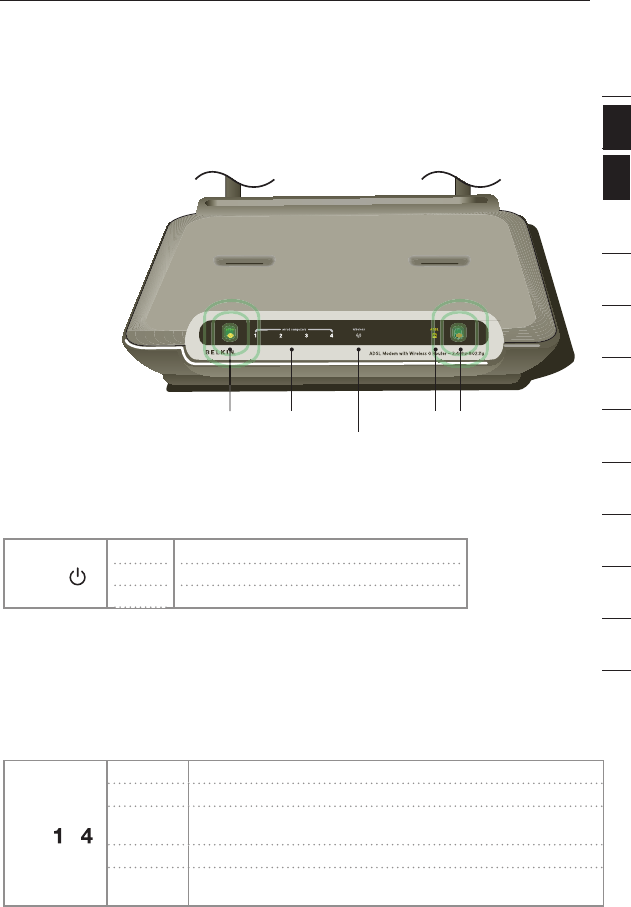
7
Knowing your Router
7
ADSL LED
Power LED LAN Status LED
(1-4) Wireless LAN (WLAN)
Status LED
Internet LED
The Router has been designed to be placed on a desktop. All of the cables
exit from the rear of the Router for better organization and utility. The LED
indicators are easily visible on the front of the Router to provide you with
information about network activity and status.
Front Panel
The illustration
shows the front
panel of the
Router:
1. Power LED
When you apply
power to the Router
or restart it, a short period of time elapses while the Router boots up. When
the Router has completely booted up, the Power LED becomes a GREEN light,
indicating the Router is ready for use.
Power
OFF
Green
Red
Power off
Power on
Router failed to start
2. LAN Status LEDs
These LAN Status LEDs are labeled 1–4 and correspond to the numbered
ports on the rear of the Router. When a computer is properly connected to
one of the LAN ports on the rear of the Router, the LED will light. Solid GREEN
means a computer or a network-enabled device is connected. When information is being
sent over the port, the LED blinks rapidly. ORANGE indicates a 10Base-T connection.
LAN
—
OFF No device is connected
Orange Ethernet link is up and 10Base-T device connected
Orange
blinking When 10Base-T device transmitting or receiving data
Green Ethernet link is up and 100Base-T connected
Green
blinking When 100Base-T device transmitting or receiving data
section
2
1
3
4
5
6
7
8
9
10
11
12
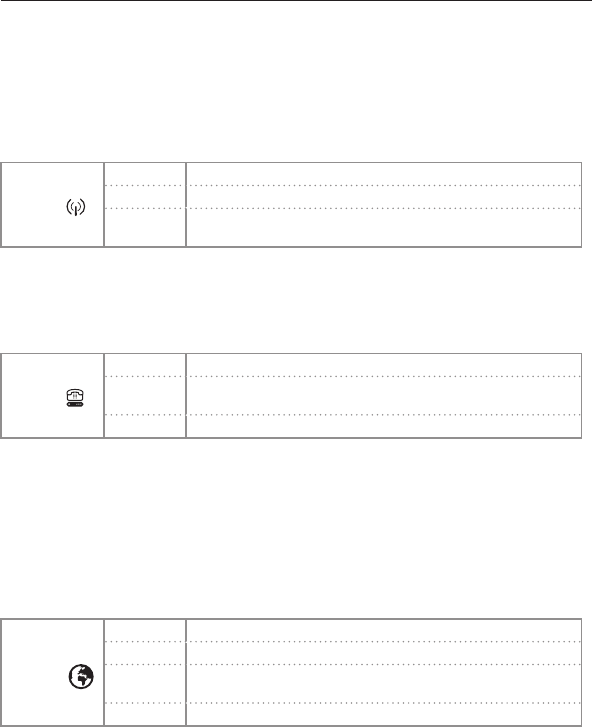
98
Knowing your Router
98
3. WLAN Status LED
The WLAN Status LED is solid GREEN when you enable the wireless LAN
function. It flashes when the Router is transmitting or receiving data wirelessly.
WLAN
OFF WLAN is off
Green WLAN is up and connected
Green
blinking When transmitting or receiving data
4. ADSL LED
The ADSL LED flashes GREEN during negotiation with your ISP. It stays
GREEN when the Router is connected properly to your ADSL service.
ADSL
OFF No ADSL connection
Green
blinking Negotiating connection
Green ADSL link is up and connected
5. Internet LED
The Internet LED shows you when the Router is connected to
the Internet. When the LED is OFF, the Router is NOT connected
to the Internet. When the LED is solid GREEN, the Router
is connected to the Internet. When the LED is blinking, the
Router is transmitting or receiving data from the Internet.
Internet
OFF No Internet connection
Green Connected to the Internet
Green
blinking When transmitting or receiving data
Red Failed to get IP
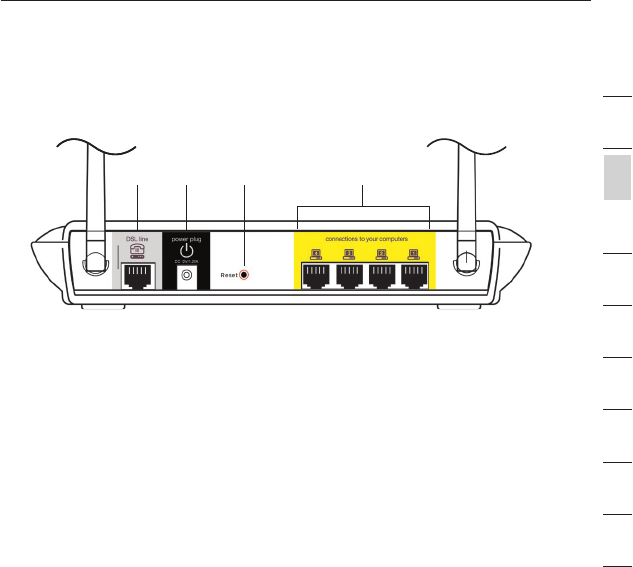
9
Knowing your Router
9
section
2
1
3
4
5
6
7
8
9
10
Back Panel
The following figure illustrates the rear panel of your Router.
6. DSL Line
This port is for connection to your ADSL line.
Connect your ADSL line to this port.
7. Power Plug
Connect the included 15V DC power supply to this inlet. Using the
wrong type of power adapter may cause damage to your Router.
8. Reset Button
The “Reset” button is used in rare cases when the Router may function
improperly. Resetting the Router will restore the Router’s normal
operation while maintaining the programmed settings. You can also
restore the factory default settings by using the Reset button. Use the
restore option in instances where you may have forgotten your custom
password.
a. Resetting the Router
Push and hold the “Reset” button for one second then release it.
When the “Power/Ready” light becomes solid again, the reset is
complete.
b. Restoring the Factory Defaults
Press and hold the Reset button for five seconds then release it.
When the Power/Ready light becomes solid again, the restore is
complete.
9. Ethernet Ports
The Ethernet ports are RJ45, 10/100 auto-negotiation. The ports are
labeled 1 through 4. These ports correspond to the numbered LEDs on
the front of the Router. Connect your network-enabled computers or
any networking devices to one of these ports.
(9)
(8)
(7)
(6)
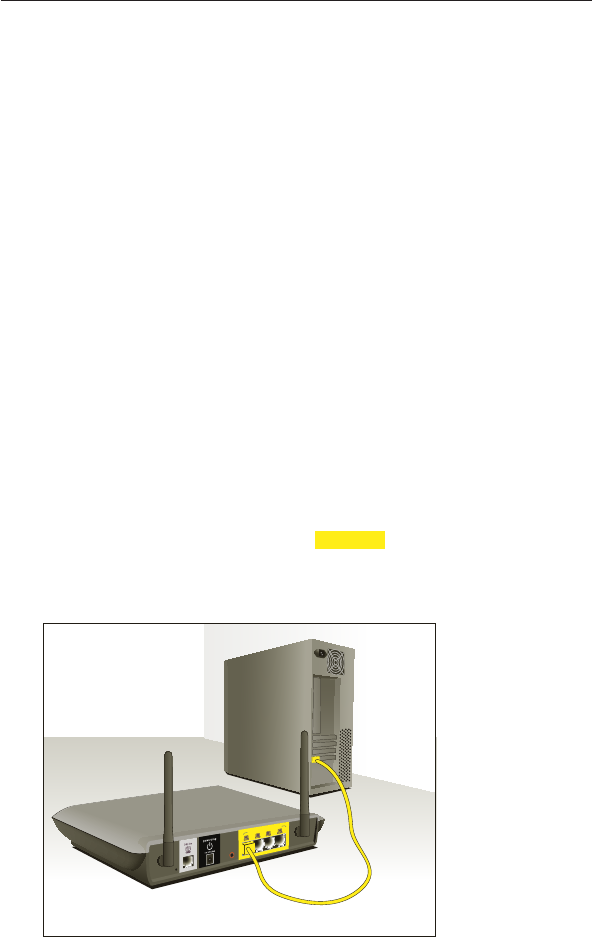
1110
Connecting your Router
1110
Positioning your Router
Your wireless connection will be stronger the closer your computer is to
your Router. Typical indoor operating range for your wireless devices is
between 100 and 200 feet. In the same way, your wireless connection and
performance will degrade somewhat as the distance between your Router
connected devices increases. This may or may not be noticeable to you.
As you move farther from your Router, connection speed may decrease.
Factors that can weaken signals simply by getting in the way of your
network’s radio waves are metal appliances, or obstructions, and walls.
Please see “Appendix B: Important Factors for Placement and Setup” in this
User Manual for more guidelines.
If you have concerns about your network’s performance that might be
related to range or obstruction factors, try moving the computer to a
position between five and 10 feet from the Router, in order to see if distance
is the problem. If difficulties persist even at close range, please see the
Troubleshooting section for solutions.
Connecting your Computers
1. Power off your computers and networking equipment.
2. Connect your computer to one of the YELLOW RJ45 ports on the rear
of the Router labeled “connections to your computers” by using an
Ethernet networking cable (one Ethernet network cable is supplied).
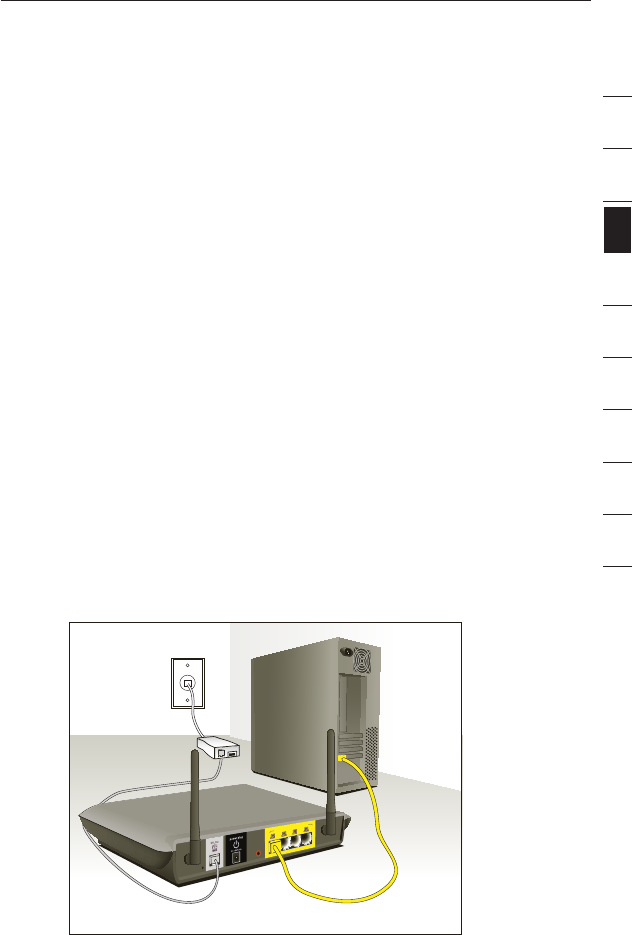
11
Connecting your Router
11
section
2
1
3
4
5
6
7
8
9
10
Connecting your ADSL Line
Connection for the Router to the ADSL line varies by country and region.
Typically it involves a microfilter or a microfilter with built-in splitter to allow
simultaneous use of ADSL service and telephone service on the same telephone
line. Please read the following steps carefully and select appropriate method.
1. If your telephone service and ADSL service are on the same telephone
line, ADSL microfilters are needed for each telephone and device, such as
answering machine, fax machine, and caller ID display. Additional splitters
may be used to separate telephone lines for telephone and the Router.
Note
: Do not connect the ADSL microfilter between the walljack and the
router. This will prevent ADSL service from reaching the modem.
2. If your telephone service and ADSL service are on the same telephone
line and you are using an ADSL microfilter with built-in splitter, connect
the splitter to the telephone wall jack providing ADSL service. Then,
connect the telephone cord from the ADSL microfilter RJ11 port
generally labeled “DSL” to the gray RJ11 port labeled “DSL line” on the
back of your Router. Connect telephony device to the other port on the
ADSL splitter commonly labeled “Phone”. An additional ADSL microfilter
is needed for another telephone and device on the same line.
Note: One RJ11 telephone cord is supplied. When inserting an RJ11
plug, be sure the tab on the plug clicks into position to ensure that it is
properly seated.
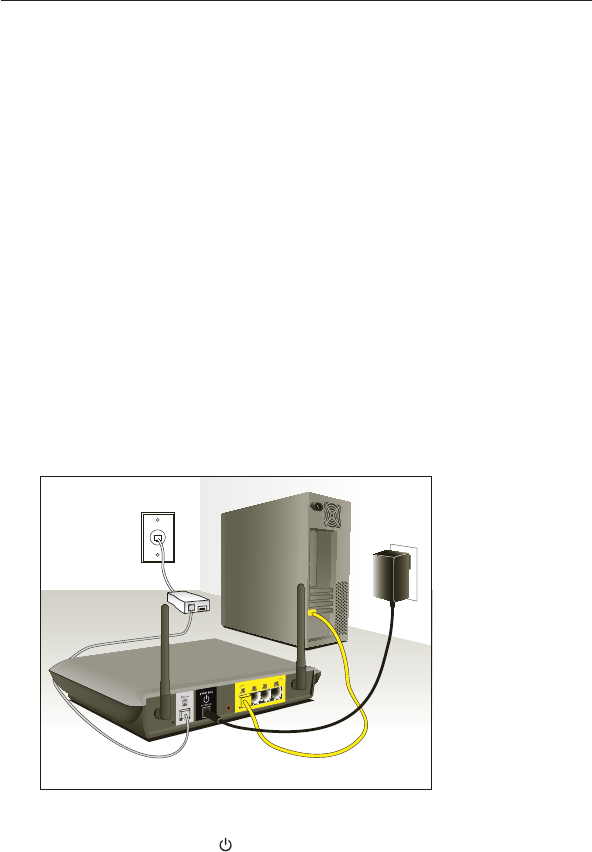
1312
Connecting your Router
1312
3. If you have a dedicated ADSL service telephone line with an RJ11 wall
jack, simply connect a telephone cord from the wall jack to the gray RJ11
port labeled “DSL line” on the back of your Router.
4. If you have an RJ45 wall jack for your ADSL service, connect an RJ45-
to-RJ11 converter to the wall jack. Then connect one end of a telephone
cord to the converter and the other end to the gray RJ11 port labeled
“DSL line” on the back of your Router.
Note: ADSL microfilter may or may not be
provided depending on your country.
Powering up your Router
1. Connect the supplied power adapter to the Router
power-input plug labeled “Power”.
Note: For safety and performance reasons, only use the supplied power
adapter to prevent damage to the Router.
2. After connecting the power adapter and the power source is turned on,
the Router’s power icon on the front panel should be on. It might
take a few minutes for the Router to fully start up.
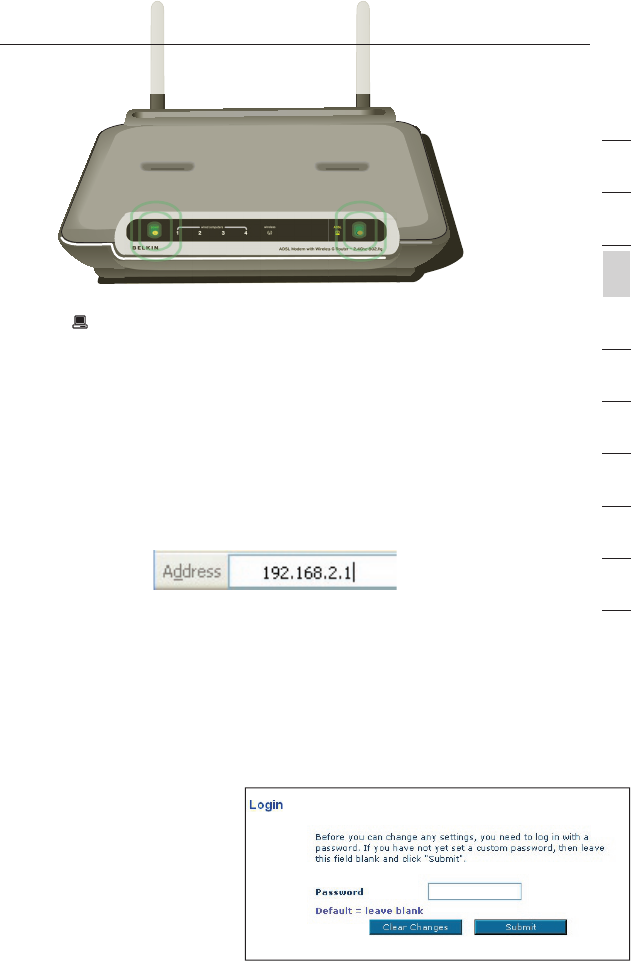
13
13
section
2
1
3
4
5
6
7
8
9
10
3. Turn on your computers. After your computers boot up, the LAN status
LED on the front of the Router will be on for each port to which a
wired computer is connected. These lights show you the connection
and activity status. Now you are ready to configure the Router for
ADSL connection.
Running the Setup Wizard
1. You can access the web-based management user interface of the
Router using the Internet browser on a computer connected to the
Router. Type “192.168.2.1” (do not type in anything else such as “http://”
or “www”) in your browser’s address bar. Then press the “Enter” key.
Note: It is strongly recommended that you use a computer
physically connected to the Router with an RJ45 cable for initial setup. Using
a wirelessly connected computer for initial setup is not recommended.
2. The following screen will appear in your browser to prompt you to login. The
Router shi ps with no password entered. In the login screen, leave the password
blank and click the “Submit” button to log in.
Note: It is strongly recommended that you change the password to your own,
for increased security.
Please read the following
section entitled “Manually
configuring your
Router”, for details on
how to change your
password and to reference
other security features.
Connecting your Router
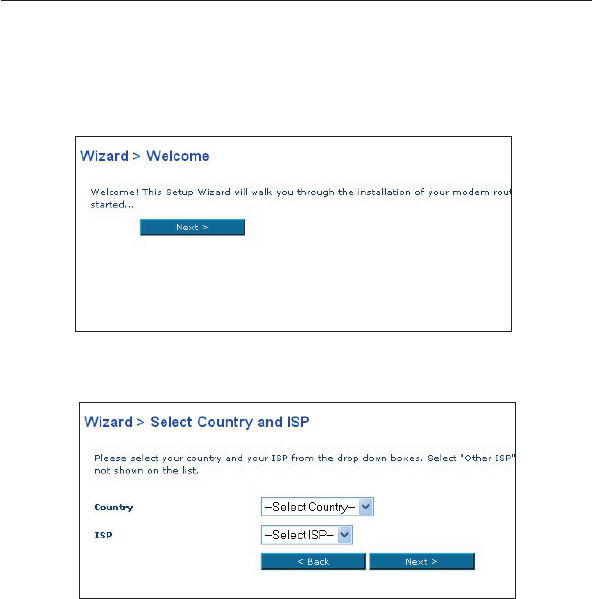
1514
Connecting your Router
1514
3. The Setup Wizard will start automatically for express
configuration (recommended) Click “Next” to continue.
Connecting your Router
4. The first step is to select your country and ISP, and click “Next”. If your
country and/or ISP is not listed, select “Other Country” or “Other ISP.”
5. Then select your connection type, PPPoE, PPPoA, or other types. For
the “PPPoE” or “PPPoA” you will see the following screen (opposite
page). Enter the required values provided by your ISP and click “Next”.
Note: For more detailed instruction on other connection types, please refer to
the “Manually Configuring your Router” section of this User Manual.
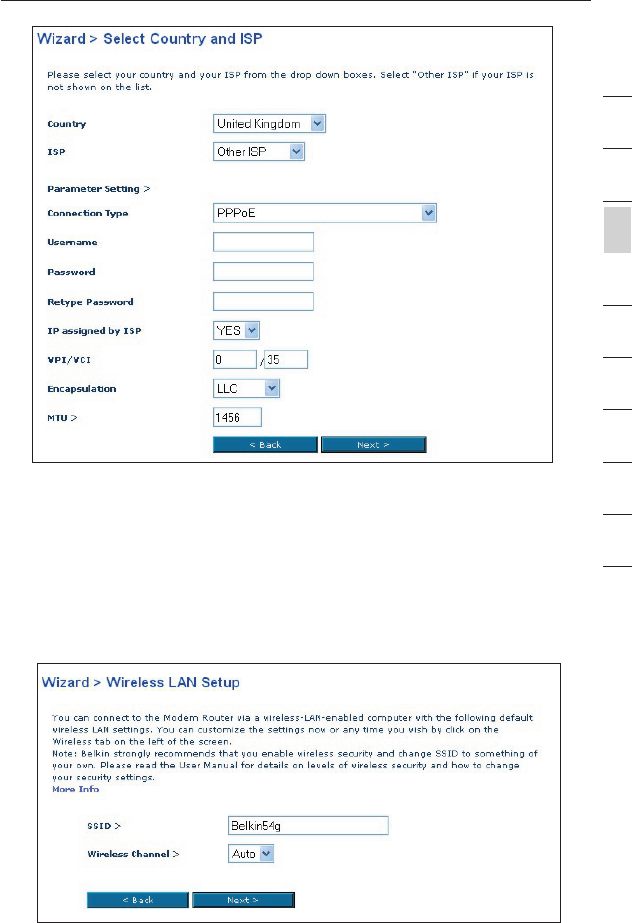
15
15
section
2
1
3
4
5
6
7
8
9
10
Connecting your Router
6. Now the Wireless LAN Setup screen will show. You can connect
to the Router via a wireless-LAN-enabled computer with the
following default wireless LAN settings:
SSID = Belkin54g Wireless Channel = Auto Security = off
Note: Belkin strongly recommends that you enable wireless security to
WEP or WPA and change SSID to something of your own. Please read
the User Manual for details on levels of wireless security and how to
change your security settings
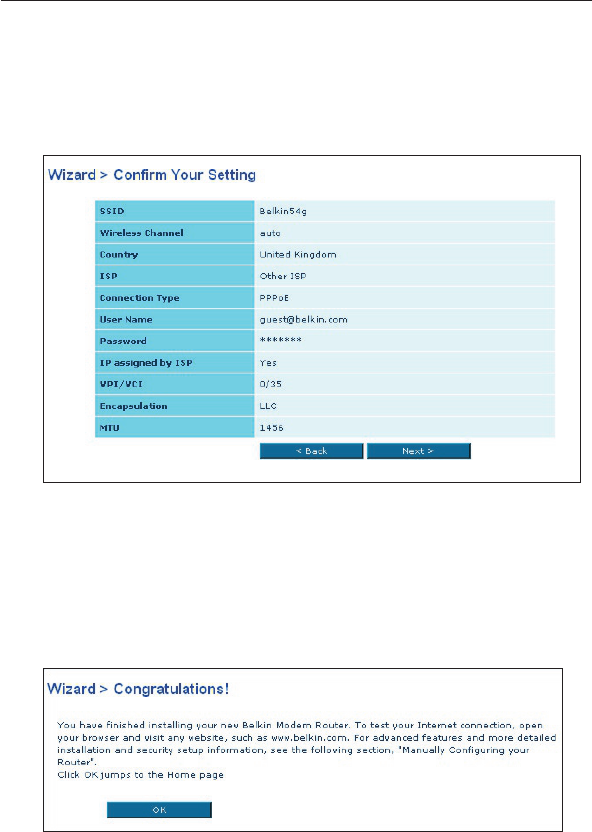
1716 1716
7. Double-check the settings shown on the following screen. You can
click “Back” to change the settings or click “Next” to confirm
Note: You can always restart the Setup Wizard or use the Navigation
Menu on the left to change your setting.
8. Congratulations! You have finished installing your new Belkin
Router. Click “OK” to activate your settings. To test your
Internet connection, open your browser and visit any website,
such as www.belkin.com. For advanced features and more
detailed installation and security setup information, see the
following section, “Manually Configuring your Router”.
Connecting your Router
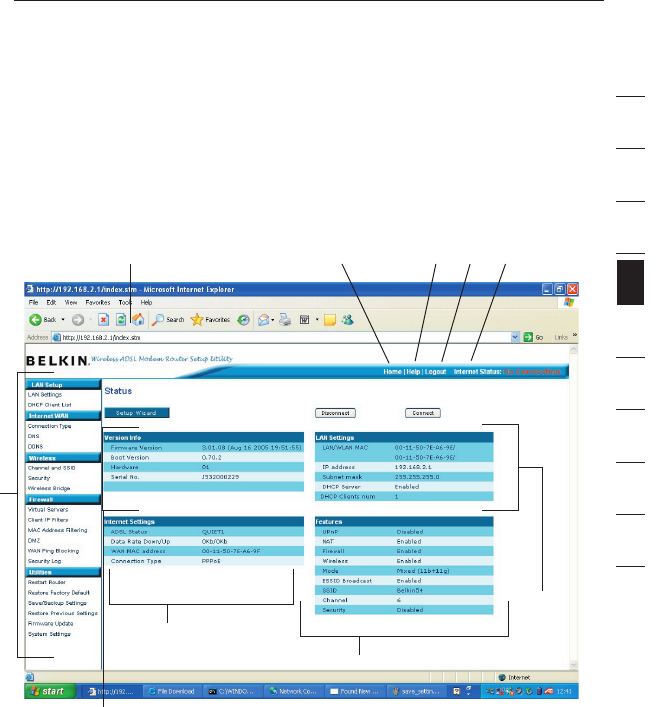
1717
section
2
1
3
4
5
6
7
8
9
10
12
Understanding the Web-Based User Interface
The home page shows you a quick view of the Router’s status and settings. All
advanced setup pages can be reached from this page.
1
. Quick-Navigation Links
You can go directly to any of the Router’s UI pages by clicking directly
on these links. The links are divided into logical categories and grouped
by tabs to make finding a particular setting easier to find. Clicking on the
header of each tab will show you a short description of the tab’s function.
2. Home Button
The “Home” button is available in every page of the UI. Pressing this
button will take you back to the home page.
3. Help Button
The “Help” button gives you access to the Router’s help pages. Help
is also available on many pages by clicking “more info” next to certain
sections of each page.
Manually Configuring your Router
(1)
(2) (5)(4)(3)
(10)
(6)
(7)
(8)
(9)

1918
Manually Configuring your Router
1918
4. Login/Logout Button
This button enables you to log in and out of the Router with the press of
one button. When you are logged into the Router, this button will change
to read “Logout”. Logging into the Router will take you to a separate login
page where you will need to enter a password. When you are logged into
the Router, you can make changes to the settings. When you are finished
making changes, you can log out of the Router by clicking the “Logout”
button. For more information about logging into the Router, see the section
called “Logging into the Router”.
5. Internet Status Indicator
This indicator is visible in all pages of the Router, showing the connection
status of the Router. When the indicator says “connection OK” in GREEN,
the Router is connected to the Internet. When the Router is not connected
to the Internet, the indicator will read “no connection” in RED. The indicator
is automatically updated when you make changes to the settings of the
Router.
6. LAN Settings
Shows you the settings of the Local Area Network (LAN) side of the
Router. Changes can be made to the settings by clicking the “LAN” “Quick
Navigation” link on the left side of the screen.
7. Features
Shows the status of the Router’s UPnP, NAT, and firewall features. Changes
can be made to the settings by clicking on any one of the links or by
clicking the “Quick Navigation” links on the left side of the screen.
8. Internet Settings
Shows the settings of the Internet/WAN side of the Router that connects to
the Internet. Changes to any of these settings can be made by clicking on
the “Internet/WAN” “Quick Navigation” link on the left side of the screen.
9. Version Info
Shows the firmware version, boot-code version, hardware version, and
serial number of the Router.
10. Page Name
The page you are on can be identified by this name. This manual will
sometimes refer to pages by name. For instance, “LAN > LAN Settings”
refers to the “LAN Settings” page.
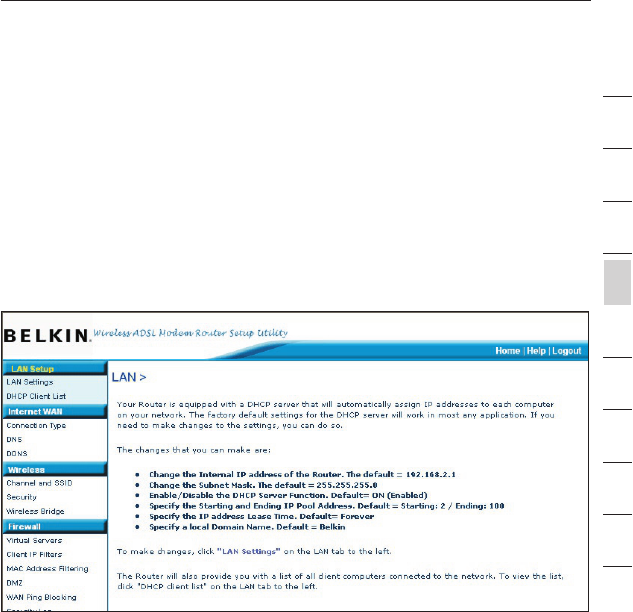
19
Manually Configuring your Router
19
section
2
1
3
4
5
6
7
8
9
10
Changing LAN Settings
All settings for the internal LAN setup of the Router can be viewed and
changed here.
LAN Settings
Clicking on the header of the LAN tab (A) will take you to the
LAN tab’s header page. A quick description of the functions can
be found here. To view the settings or make changes to any of
the LAN settings, click on “LAN Settings” (B) or to view the list
of connected computers, click on “DHCP Client List” (C).
1. IP Address
The “IP address” is the internal IP address of the Router. The default
IP address is “192.168.2.1”. To access the setup interface, type this
IP address into the address bar of your browser. This address can
be changed if needed. To change the IP address, type in the new
IP address and click “Apply Changes”. The IP address you choose
should be a non-routable IP. Examples of a non-routable IP are:
192.168.x.x (where x is anything between 0 and 255)
10.x.x.x (where x is anything between 0 and 255)
2. Subnet Mask
There is no need to change the subnet mask. This is a unique,
advanced feature of your Belkin Router.
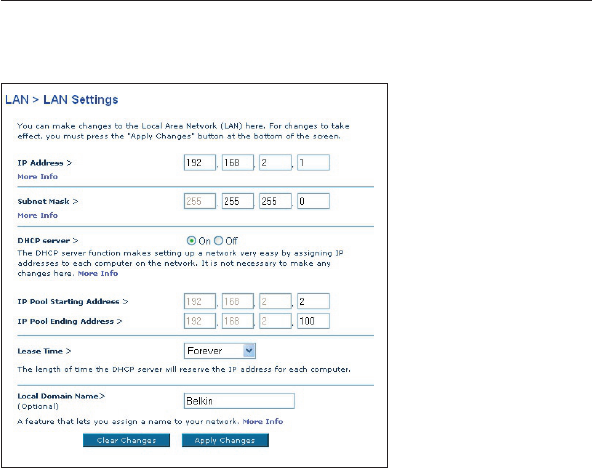
2120
Manually Configuring your Router
2120
3. DHCP Server
The DHCP server function makes setting up a network very easy by
assigning IP addresses to each computer on the network automatically.
The default setting is “On”. The DHCP server can be turned OFF if
necessary, however, in order to do so you must manually set a static IP
address for each computer on your network. To turn off the DHCP server,
select “Off” and click “Apply Changes”.
4. IP Pool
The IP Pool is the range of IP addresses set aside for dynamic assignment
to the computers on your network. The default is 2–100 (99 computers). If
you want to change this number, you can do so by entering a new starting
and ending IP address and clicking on “Apply Changes”. The DHCP server
can assign 100 IP addresses automatically. This means that you cannot
specify an IP address pool larger than 100 computers. For example, starting
at 50 means you have to end at 150 or lower so as not to exceed the 100-
client limit. The starting IP address must be lower in number than the ending
IP address.
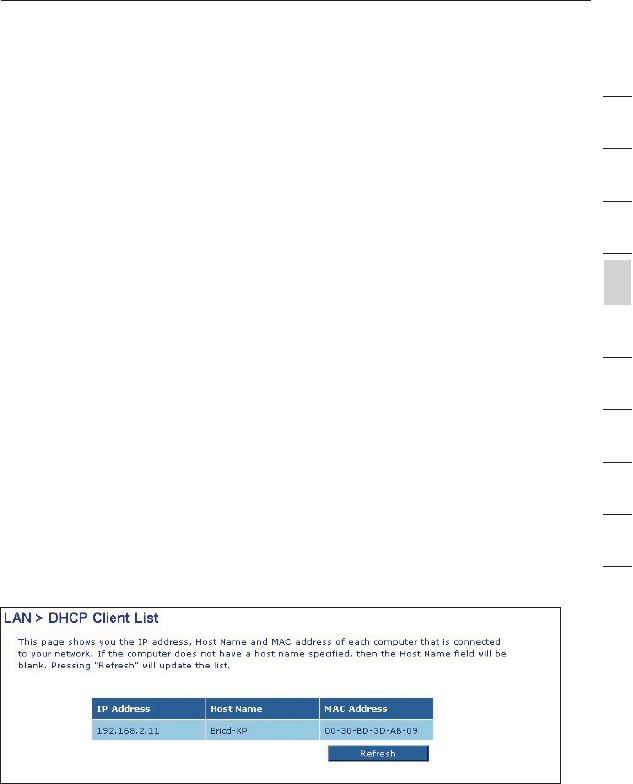
21
Manually Configuring your Router
21
section
2
1
3
4
5
6
7
8
9
10
5. Lease Time
Lease time is the length of time the DHCP server will reserve the IP
address for each computer. We recommend that you leave the lease
time set to “Forever”. The default setting is “Forever”, meaning that any
time a computer is assigned an IP address by the DHCP server, the IP
address will not change for that particular computer. Setting lease times
for shorter intervals, such as one day or one hour, frees IP addresses after
the specified period of time. This also means that a particular computer’s
IP address may change over time. If you have set any of the other
advanced features of the Router, such as DMZ or client IP filters, these
are dependent on the IP address. For this reason, you will not want the IP
address to change.
6. Local Domain Name
The default setting is “Belkin”. You can set a local domain name (network
name) for your network. There is no need to change this setting unless
you have a specific advanced need to do so. You can name the network
anything you want such as “MY NETWORK”.
DHCP Client List
You can view a list of the computers (known as clients), which are connected to
your network. You are able to view the IP address (1) of the computer, the host
name (2) (if the computer has been assigned one), and the MAC address (3) of
the computer’s Network Interface Card (NIC). Pressing the “Refresh” (4) button
will update the list. If there have been any changes, the list will be updated.
Internet WAN
The “Internet WAN” tab is where you will set up your Router to connect
to your Internet Service Provider. The Router is capable of connecting
to virtually any ADSL Service Provider’s system provided you have
correctly configured the Router’s settings for your ISP’s connection
type. Your connection settings are provided to you by your ISP.
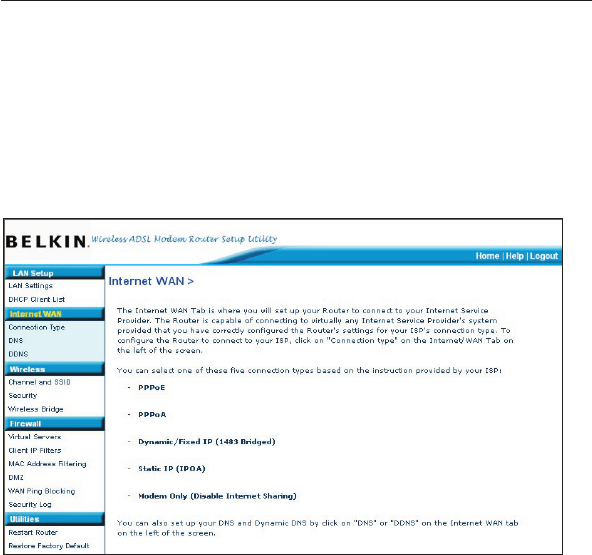
2322
Manually Configuring your Router
2322
To configure the Router with the settings that your ISP gave you, click
“Connection Type” (1) on the left side of the screen. Select the connection
type you use. If your ISP gave you DNS settings, clicking “DNS” (2) allows
you to enter DNS address entries for ISPs that require specific settings.
When you have finished making settings, the “Internet Status”
indicator will read “Connected” if your Router is set up properly.
Connection Type
From the “Connection Type” page, you can select one of these five
connection types based on the instruction provided by your ISP:
PPPoE
PPPoA
Dynamic IP (1483 Bridged)
Static IP (IPoA)
Modem Only (Disable Internet Sharing)
Note: See Appendix C in this User Manual for some common DSL
Internet setting parameters. If you are not sure, please contact your ISP.
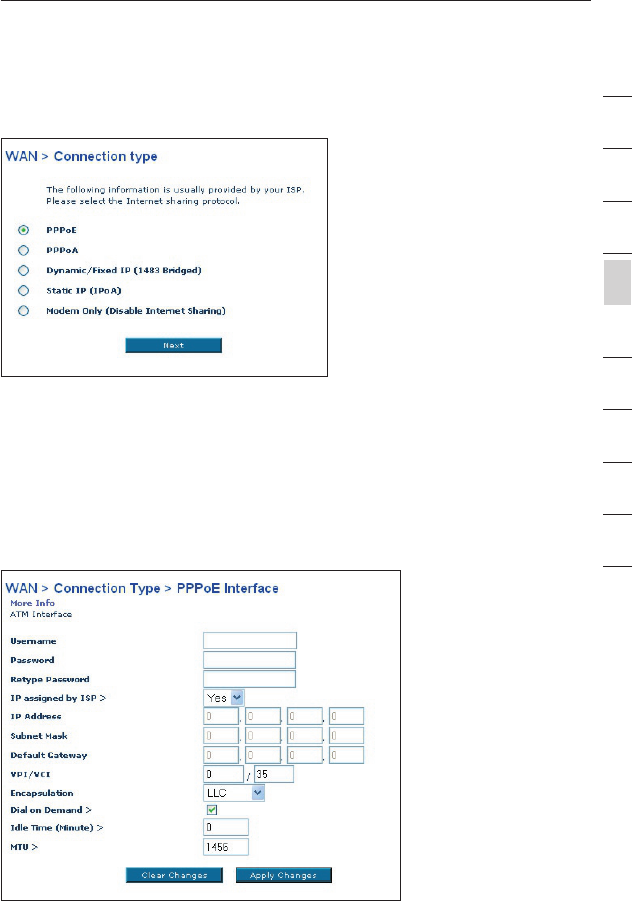
23
Manually Configuring your Router
23
section
2
1
3
4
5
6
7
8
9
10
Select the type of connection you use by clicking the radio button
(1) next to your connection type and then clicking “Next”.
Setting your ISP Connection Type to PPPoE or PPPoA
PPPoE (Point-to-Point Protocol over Ethernet) is the standard method of
connecting networked devices. It requires a user name and password to
access the network of your ISP for connecting to the Internet. PPPoA (PPP
over ATM) is similar to PPPoE, but is mostly implemented in the UK. Select
PPPoE or PPPoA and click “Next”. Then enter the information provided
by your ISP, and click “Apply Changes” to activate your settings.
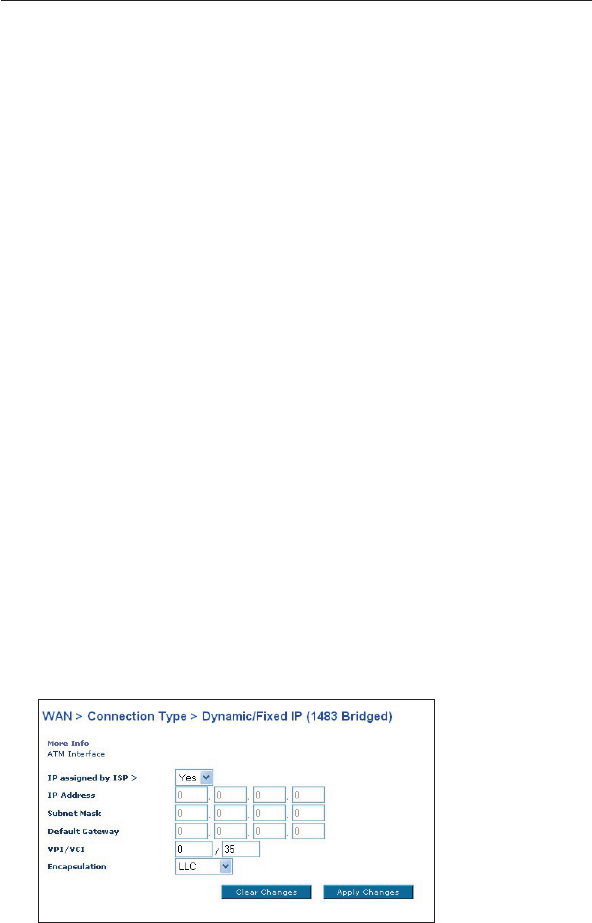
2524
Manually Configuring your Router
2524
1. User Name - Enter the user name. (Assigned by your ISP).
2. Password - Enter your password. (Assigned by your ISP).
3. Retype Password - Confirm the password.
(Assigned by your ISP).
4. IP Assigned by ISP – Leave “Yes” if your ISP automatically
assigns IP address. If your ISP assigned a fixed IP address,
select “No” and enter assigned values.
5. VPI/VCI - Enter your Virtual Path Identifier (VPI) and Virtual
Circuit Identifier (VCI) parameter here. (Assigned by your ISP).
6. Encapsulation - Select your encapsulation type (supplied by
your ISP) to specify how to handle multiple protocols at the
ATM transport layer. VC-MUX: PPPoA Virtual Circuit Multiplexer
(null encapsulation) allows only one protocol running per virtual
circuit with fewer overheads. LLC: PPPoA Logical Link Control
allows multiple protocols running over one virtual circuit (more
overhead).
7. Dial on Demand - By selecting “Dial on Demand” your Router
will automatically connect to the Internet when a user opens up a
web browser.
8. Idle Time (Minutes) - Enter the maximum idle time for the
Internet connection. After this time has been exceeded, the
connection will be terminated.
9. MTU - The MTU setting should never be changed unless your you
a specific MTU setting. Making changes to the MTU can cause
problems with your Internet connection including disconnection
from the Internet, slow Internet access and problems with
Internet applications working properly.